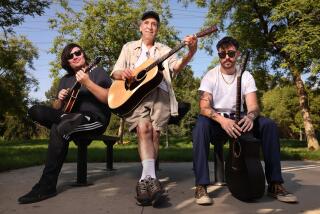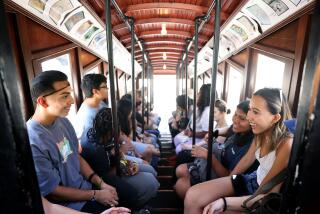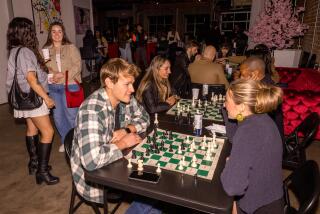Card Game’s Revival at High Schools Bridges the Generation Gap
Not too long ago, the thought of bridge for Joshua Solomin conjured images of aging nursing home residents sitting around a table playing an insipid card game. Now, the 18-year-old Stanford freshman finds himself scouring his college dorm for bridge partners.
“I never expected that [bridge] was something that would appeal to me and my group of high school-aged friends,” Solomin confessed. “But I really like it now.”
Solomin discovered his new hobby last year as a senior at North Hollywood High School, where he was a founding member of the campus bridge club. Although most high schools plug chess as the intellectual extracurricular activity of choice, North Hollywood is among a smattering of schools around Los Angeles that are starting to bequeath the benefits of bridge to its students.
Once considered a card game relegated to the dining rooms of the middle-aged, bridge is slowly finding a place among teenagers as students pair off and try to out-strategize their opponents.
“You really have to understand your partner and you have to think hard to pull together a plan, which is fun,” said North Hollywood sophomore Lily Lam, who learned to play in September. “Plus, it’s another excuse to hang out with friends.”
If only a handful of public schools in Los Angeles have bridge clubs, even fewer have clubs registered with a national organization that enables their students to compete in tournaments. North Hollywood High and Saddleback High School in Orange County are the only Southern California schools registered with the American Contract Bridge League, the group that sponsors competitions and oversees most official bridge clubs.
Bridge-playing teachers at both schools decided independently to spread the game’s message of memory, math and moxie.
“At first, the students were intrigued but thought it was a strange idea when I suggested teaching them bridge,” said Kailim Toy, a North Hollywood High School history teacher who’s been playing the game for more than 25 years. “But it kind of clicked for several of them.”
Before they got hooked on bridge, the students mainly played card games such as gin rummy, hearts, spit or Japanese poker, Toy said. But they liked bridge so much more that when they returned to school after summer vacation, they began playing at lunch. After a couple of months they sought Toy’s help to become an official club and attract more members.
Similarly, the private Brentwood School started a group in September, Eagle Rock High School is hoping to revive the bridge club it had last year and El Camino Real High School in Woodland Hills will start its club later this month.
Just as chance has little part in a well-played game of bridge, so the sudden flurry of high school bridge clubs is at least partly because of the efforts of Tony Greenberg, president of the Los Angeles Chapter of the American Contract Bridge League. Greenberg has been calling city schools to push his favorite game.
“For the past few years we’ve been making a pitch to get bridge into the schools, to teach young people to play so that the concept that it’s an old person’s game vanishes,” said Charlotte Blaiss, director of youth and junior players at the nonprofit American Contract Bridge League.
The average age of league members is 66, the generation that was in college during the ‘50s when bridge was big. But the game’s popularity faded during the late ‘60s and never really regained popularity among young people.
Today, the bridge league actively recruits young members, but its gains are slow. Blaiss said that many European countries, such as the Netherlands, France and Belgium, have incorporated bridge into their schools’ curricula to create a new generation of players. She’s hoping that the organization’s bridge lessons, started in 1987, will help attract more youths.
Though the organization makes money from members’ dues and nominal tournament fees, the interest in attracting young players is solely to keep the game alive in the United States, Blaiss said. “Once young people understand it and get involved with it, they realize bridge is a game you never stop learning.”
Bridge is primarily a game of skill with a little bit of luck, depending on which version you play. The game, which has its roots in 16th century England, is similar to spades but requires more logic, a knowledge of probability and deft communication with one’s partner.
Although North Hollywood High’s bridge club certainly isn’t the school’s most popular group, it has amassed a respectable following. About 30 students meet every Friday at lunch in Toy’s classroom to partner up and play bridge for about 30 minutes.
At a recent lunch-hour game at North Hollywood High, gone was the sedate sipping of coffee or tea that once went hand-in-hand with an after-dinner game. Instead, students slurped noodles and munched Doritos as they dealt decks of cards adorned with Bugs Bunny, the Tasmanian Devil and Marvin the Martian.
As the first group of four students sidled up to a table in Toy’s classroom, sophomore Esther Kim and her partner, senior Ann Wang, eyed their cards and then each other before Kim started the bidding.
“Pass.” “Pass.” “Pass.” Each player declined to bid until sophomore Lily Lam bid one diamond. Her oral offer accomplished two things--it told her partner that she had enough diamonds to complete a suit, and it gave her partner a clue of what to bid next. But Lam’s partner, Vincent Gu, missed the cue. Eventually, it was Esther Kim and her partner who became the high bidders and established the “contract” necessary to win coveted points.
Those four were neophytes, still learning how to bid and throw out trump cards and “tricks” or high cards. The more sophisticated players, such as sophomore Raymond Tsai, bid quickly and play with careful calculations that exemplify their skill in the game.
“I think bridge interests me so much because it’s a very intellectual game,” said Tsai, 15, who’s been playing for six months.
“If you really play the game well, when the first card is tossed you can just sit there for a minute and concentrate and you can figure out your plan for the entire game,” he explained. “That’s what’s so cool about the game.”
For Tsai’s partner, senior George Lee, it’s all in the communication.
“The people I regularly play with like to get into the more complex aspects of the game and that’s when it really gets interesting,” said Lee, who learned how to play by watching the original members of North Hollywood’s bridge club. Now, he and Tsai are a fearsome duo, frustrating more than one pair of opponents.
“A lot of people from other schools think it’s strange that I play bridge, but it’s a challenge and that’s what I like about it,” he said.
Ever since he learned the game about a year ago, Lee has held a summer bridge workshop at the Northridge library and has competed at a few tournaments--several of them with his partner, Tsai.
“Whenever we go to tournaments, we’re the only people who are young,” Lee said. “At first it’s kind of intimidating, but then you kind of get used to it. And most of the older people are pretty glad to see some young faces. It’s something new for them.”
More to Read
The biggest entertainment stories
Get our big stories about Hollywood, film, television, music, arts, culture and more right in your inbox as soon as they publish.
You may occasionally receive promotional content from the Los Angeles Times.










